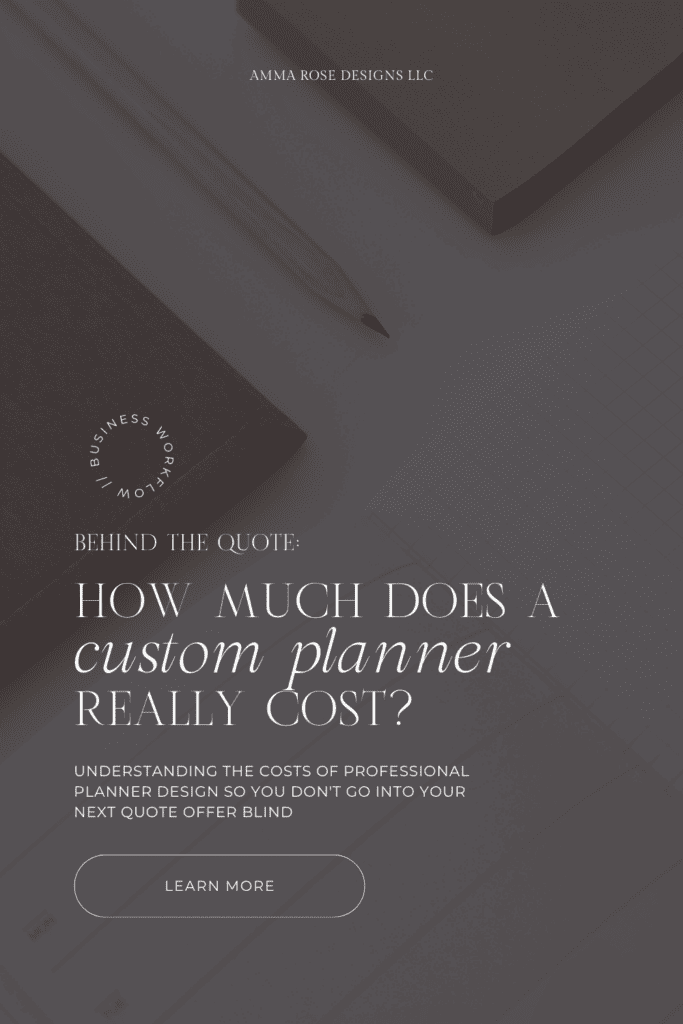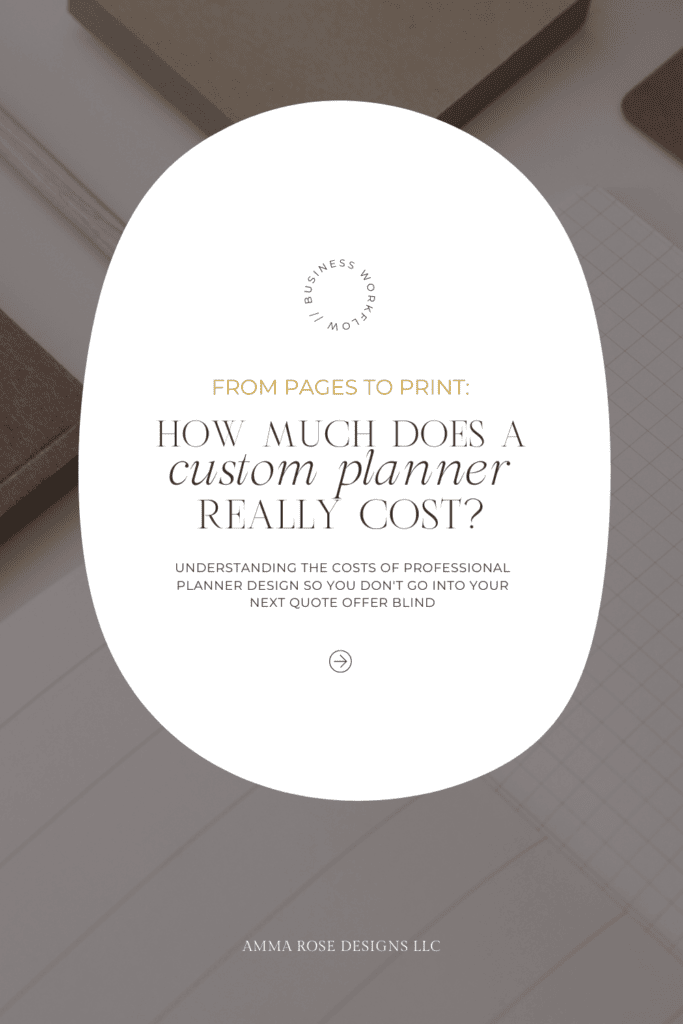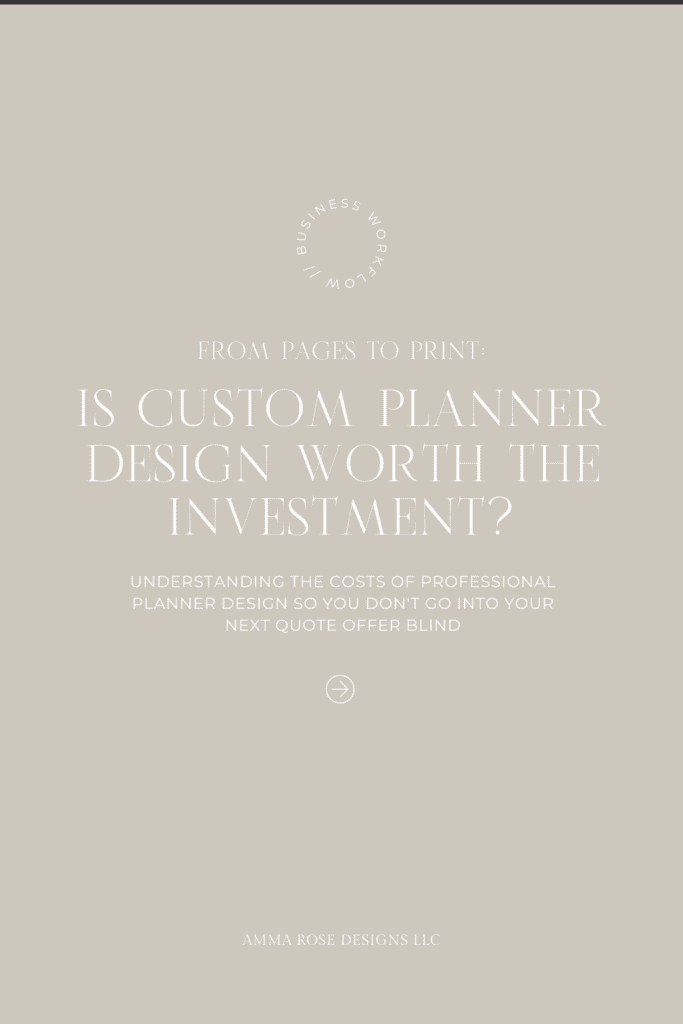
The Costs of Getting a Custom Planner Designed by a Professional Graphic Designer
Are you considering introducing planners into your business model or expanding your existing planner product line? Smart move! Planners are more than just tools for organization—they can also be a powerful vehicle to boost your brand’s value and diversify your income streams. However, to truly stand out in the crowded marketplace and provide unique value to your customers, considering a custom planner design by a professional could be your ticket to success. But what does that cost?
Navigating the financial aspect of a custom planner project can be a bit like trying to decode a secret language, especially if you’re new to the scene. Don’t worry, we’re here to translate and illuminate the process for you. This blog post will delve into the nitty-gritty of the costs involved in creating a custom planner that aligns with your brand, appeals to your audience, and adds to your bottom line.
We’ll explore key cost factors such as the number of pages, the level of strategy and ideation input you require from the designer, the nature of your deadlines, the type of planner (digital, printable, or printed), the designer’s skill level, and if you’re going physical, the printing costs. Each of these elements influences the final cost of the project and understanding them will enable you to make informed decisions, ensuring a smooth journey towards adding or expanding your planner product line. So, let’s dive in and decipher the costs behind creating your perfect custom planner!
Cost Factor One | Number of Pages
Let’s start our deep-dive with our first cost factor – the number of pages. Yes, just like a captivating book, your planner’s story is told through its pages, and the number of pages plays a significant role in determining the cost of your project.
Here’s the deal – the more pages your planner has, the more work it requires from your designer. Each page is a unique canvas that needs to be thoughtfully designed to align with your brand and provide value to your customer. And, well, more canvases mean more design hours. Simple math, right?
Now, you might be wondering, “What’s the cost for X number of pages?” As a point of reference, let’s say a smaller planner project, like a simple printable weekly planner of about 10-15 pages, might fall in the range of $200-$400, depending on the designer’s rates. If we move up to a more comprehensive planner—say, a 50-70 page project with daily, weekly, and monthly spreads, along with specialty pages like goal-setting sheets or habit trackers—the cost can start around $800 and go upwards.
Keep in mind, these are just ballpark figures. Actual costs can vary based on other factors we’ll discuss later in the post. The key here is to strike a balance between the number of pages (thus the amount of value you provide to your customers) and the cost you’re willing to invest in the design process. After all, the best planner for your business is one that not only delights your customers but also makes financial sense for you.
Cost Factor Two | Strategy and Ideation
Moving on to our second cost factor – strategy and ideation. This is the part where we lay the groundwork, sketching out the blueprint of your planner project. It’s the heart and soul of your planner – the part that makes your planner not just a pretty accessory, but a powerful tool for your customers.
Every great planner begins with a great idea, right? But, morphing that idea into a concrete, functional, and user-friendly planner requires thoughtful strategy and ideation. It’s not just about designing beautiful pages; it’s about designing a product that aligns with your brand, serves your audience’s needs, and ultimately, helps you achieve your business goals.
And here’s the catch – the involvement of your designer in this strategy and ideation phase can add to your costs. Why? Because this stage often includes competitor research, audience analysis, brainstorming sessions, sketching layouts, and more – all crucial elements that add hours to the designer’s workload.
The depth of strategic involvement varies by designer. Some may simply design based on your specific instructions, while others offer a more comprehensive service, guiding you through the entire process of ideating, strategizing, and designing a successful planner from scratch.
Yes, this added expertise can increase your upfront cost. But think of it as an investment in your product’s success. A planner designed with a well-thought-out strategy can resonate more with your audience, leading to higher customer satisfaction and ultimately, higher sales. Remember, the best investments often provide the best returns!
Cost Factor Three | Timeline and Rush Orders
And now, let’s chat about the third cost factor – your project timeline. In the world of graphic design, time is often equated with money. The quicker you need your custom planner designed and ready to hit the market, the more it could potentially cost you. Let’s unpack why that is.
Every project comes with a deadline. Maybe you want to launch your planner for the new year, or perhaps you’re gearing up for a big product release event. Whatever your timeline, your designer will need to plan their work schedule around it.
Here’s where it gets interesting – if you need your project completed pronto, you might be looking at what we in the biz call a ‘rush order’. Rush orders require the designer to prioritize your project above others, often meaning longer work hours and sometimes even weekend work to get everything done on time. It’s like asking for overnight shipping compared to standard delivery – it’s going to cost a bit more.
While not every designer offers rush services, those who do often charge a premium for it. The extra fee compensates for the additional hours and the expedited nature of the work.
It’s always good practice to discuss your timeline with your designer upfront. If you’re not in a hurry, a standard project timeline could save you money. But if time is of the essence, be prepared to pay a little extra to get your beautiful custom planner designed and ready to wow your customers in record time!
Cost Factor Four | Planner Type
Alrighty, let’s dive into the fourth cost factor – the type of planner you’re planning to produce. In the planner world, we generally see three types: digital planners, printable planners, and printed (or physical) planners. Each type has its own unique design needs and, therefore, associated costs.
- Digital planners are designed to be used on digital devices like tablets and come with clickable links for easy navigation. Digital planners generally fall on the more affordable side of the spectrum because they don’t require any physical production costs. You’re mainly paying for the design work, which is reflected in the cost.
- Printable planners are designed to be downloaded and printed at home by your customers. The design needs to be printer-friendly and easy to use once printed. Like digital planners, printable planners also don’t incur any physical production costs, so the design work makes up the bulk of the price.
- Now, printed or physical planners are a different ball game. The design work is just one part of the cost. Once the planner is designed, it needs to be professionally printed, bound, and shipped. These additional steps can significantly increase the overall cost. Plus, printed planners often involve more design intricacies, like deciding on paper type, cover design, binding style, etc., which could add to the design costs.
So, in short, while digital and printable planners mainly involve costs for the design work, printed planners come with extra production costs. Remember, it’s crucial to consider not just the design, but also the type of planner that will best serve your business model and customer needs.
Cost Factor Five | Designer’s Level
Now, let’s chat about the fifth cost factor, which is a biggie: the level of your designer. Like in many professions, the experience and quality level of a designer can greatly influence their rates. After all, you’re not just paying for their time, but their expertise, creativity, and the value they bring to your project.
If we’re to bucket designers into three broad categories: low quality, mid-quality, and high-quality, here’s a simple breakdown of what you could expect:
- Low-quality designers typically are beginners who are just starting their journey in the world of design. They might have lower rates to attract initial clients and gain experience. While their designs could be decent, there might be gaps in their knowledge and they may lack the nuanced understanding of planner design that comes with experience.
- Mid-quality designers, on the other hand, have a decent amount of experience and a more robust portfolio to show for it. They are well-versed with the nuances of planner design and can deliver quality work. Their rates would be higher than a beginner, but the increased cost generally comes with a higher value proposition.
- High-quality designers are the cream of the crop. They have years of experience, a strong portfolio, and possibly, a list of successful planners to their credit. They have a deep understanding of the ins and outs of planner design, and their work reflects their expertise. Their rates would be on the higher side, but remember, you’re paying for top-tier expertise and the peace of mind that comes with knowing your planner is in expert hands.
Remember, friends, the level of designer you choose should align with your business goals and budget. While it’s tempting to save money by going for a cheaper option, remember that a well-designed, functional planner can boost your profits significantly in the long run. It’s an investment, so choose wisely!
Cost Factor Six | Printing Costs (if applicable)
Alrighty then, let’s dive into the sixth and final cost factor, which is a critical one for physical planners: printing costs. Now, this is a broad area with many variables, so bear with me as we sift through the details.
When it comes to getting your beautiful planner printed after it’s been designed, you have a few options. You could go for a far east printer, a local printer, or a print-on-demand service. Each of these has its pros and cons, and the costs can vary significantly.
Another crucial aspect affecting your printing costs is your choice of materials. The quality of paper, type of binding, and cover materials can make a significant difference in how your planner looks, feels, and lasts – and yes, in how much it costs. A spiral-bound planner with a hardcover and high-quality paper will cost more to produce than a saddle-stitched one with a paper cover.
In essence, choosing your printer and materials is all about balancing cost, quality, and your brand’s values. And don’t forget – a well-made, high-quality planner not only delights your customers, but also reflects positively on your brand.
The costs of a professionally designed custom planner
And there we have it! We’ve walked the winding road of cost factors together, and hopefully, you’re now feeling more empowered and less in the dark about what goes into pricing a professionally designed custom planner.
From the number of pages and the ideation process to the type of planner, the level of the designer, and of course, printing costs – there’s a whole lot that’s taken into consideration. But remember, it’s not just about the dollars you’re spending. It’s about the value you’re getting in return, and trust me, a well-designed, high-quality planner is worth every penny. It can elevate your brand, delight your customers, and even become a steady stream of revenue for your business.

So, are you ready to create a custom planner that captivates your audience and boosts your brand? I encourage you to reach out for a personalized quote for your planner project. I can’t wait to help bring your vision to life!
Till then, keep dreaming big and planning strategically!



